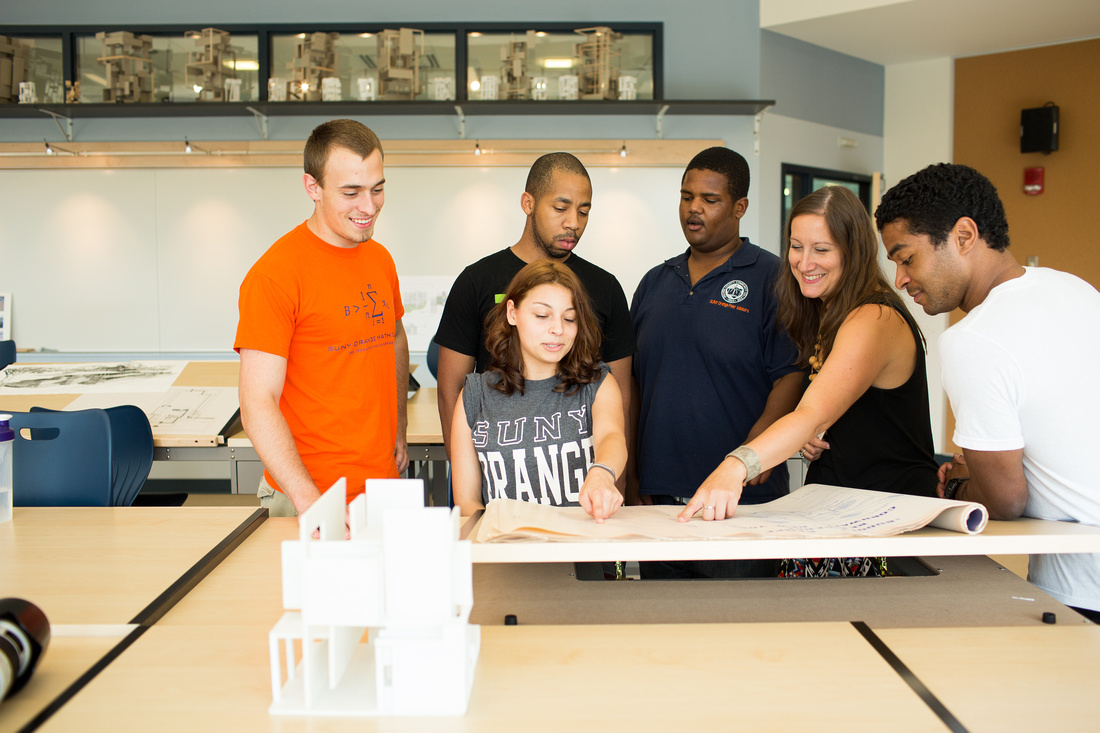Architectural Technology
- CAREER DEGREE
- MIDDLETOWN CAMPUS

Program Description
The Associate in Applied Science degree program in Architectural Technology prepares graduates to enter the workforce as architectural team members. While other opportunities exist, the largest job opportunities are positions as interns / CAD operators for architectural firms. Graduates’ skills will prepare them to produce working drawings in a variety of settings, such as engineering firms or manufacturers. If graduates have field experience in a building trade, all program outcomes are directly transferable to entry-level positions in construction management and supervision. A broad cross-section of course content is covered in the program; this familiarizes students with many aspects of the architectural profession, the work of building professionals and the construction process.
When working under the supervision of a licensed professional (i.e. Registered Architect, Professional Engineer, etc.), a graduate’s primary responsibilities would include measuring and documenting existing conditions of buildings and sites, preparing construction documents, interpreting construction documents, preparing design presentations for clients or other audiences, and coordinating architectural drawings with consultants’ drawings.
Fluency with computer-aided drawing (AutoCAD) and computer literacy, as it applies to generating architectural drawings, are fundamental skills graduates will possess. Meanwhile, freehand sketching is stressed wherever possible as a valuable communication method. Beyond preparing construction drawings, students will build models, prepare reports and orally present their work to groups.
Most courses in the program are a combination of lecture and lab. In the lecture component, foundational material is presented, often accompanied by samples, examples or other visual cues. In the lab component, students will either work on short-term exercises designed to hone very specific knowledge bases or skills or they will work on long-term projects designed to simulate the types of projects that they will eventually encounter in the workforce. Students should be prepared to spend a significant amount of time on projects outside the classroom.
Many students who enter this degree program plan to transfer to an upper division institution. Because these opportunities exist, second year students who intend to transfer should select their courses in careful consultation with their academic advisor. Portfolio production will be required.
For those students wishing to become Registered Architects, New York State Department of Education guidelines must be followed. To become a Registered Architect, one must earn an NAAB-accredited Bachelor of Architecture or Master of Architecture degree, fulfill NCARB internship requirements (a proscribed three year apprenticeship), and pass a challenging and comprehensive licensing examination.
For those students wishing to pursue baccalaureate degrees in Landscape Architecture and Construction Management, an A.S. degree from SUNY Orange with electives from the Architectural Technology degree program may be most suitable. Course selection should be made carefully in consultation with academic advisors.
A Day in the Life ...
A typical day in the life of an architecture student includes lecture and studio courses, study sessions with classmates, and conversations with professors.
Lecture/lab format reinforces skills and knowledge
Students are strongly encouraged to join the Architecture Club, where they have the opportunity to travel and experience architecture designed by world-renowned architects.
Three Reasons to Consider Architectural Technology
- This program prepares graduates to enter the workforce as architectural team members or to transfer to upper division universities to complete a Bachelor of Architecture.
- Small classes create learning communities where students are supported by classmates and professors.
- Obtain an entry-level drafter position in an architectural or engineering firm.
Program Outcomes
Students will:
- graphically communicate architectural forms and building assemblies, both two and three dimensionally
- demonstrate fluency using digital graphics software packages to produce construction drawings and other architectural representations
- solve architectural problems through the development of an aesthetic approach and the manipulation of form and space
- demonstrate an understanding of building materials and methods
- demonstrate an understanding of the coordination within a building project between architecture and related professions
- demonstrate an understanding of basic life safety and regulatory requirements in building projects
- demonstrate an understanding of fundamental structural principles
- utilize research from web based and other sources in architectural projects
- identify basic methods of sustainable building practices and their environmental impacts
- demonstrate an understanding of the historical and social context of western architecture
Keep This in Mind
This program prepares graduates to enter the workforce as architectural team members.
Approximately 50% of graduates continue their studies in Bachelor of Architecture programs.
Students may wish to purchase a laptop with modeling and rendering capabilities. The degree will also require other tools and equipment for studio work.
Students learn time and project management.
Expectations of time spent outside of lecture and lab to complete long-term projects.
Critiques are a public presentation and discussion of student work.
Admission Criteria
Admission to this program requires that students be high school graduates or have high school equivalency diplomas (HSEs). If students are home schooled, they may be eligible for admission.
Maintenance of a C average or better in courses in the major is also required.
Transfer Options
While the A.A.S. degree leads to immediate employment, SUNY Orange students have successfully transferred to:
- Alfred State College
- New York Institute of Technology
- New Jersey Institute of Technology
- Pratt Institute
- SUNY Environmental Science and Forestry
Your Career Coach
Career opportunities exist in the following areas:
- architectural firms
- engineering firms
- manufacturing firms
- construction firms
- governmental agencies
- utility companies
Program Availability Status
This program is available on the Middletown campus and requires day and some evening courses

